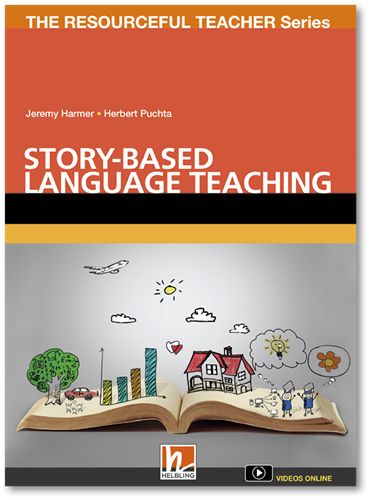Story-Based Language Teaching
Story-Based Language Teaching

Jeremy Harmer and Herbert Puchta
Helbling (2018)
Prolific and popular writers of English language teaching materials, Jeremy Harmer and Herbert Puchta join forces in exploring the possibilities of the role of stories in the language classroom. Both writers are no strangers to creating teaching materials that place the student at the heart of the lesson and utilise a straightforward writing style that makes it an incredibly accessible and inspiring read.
As language teachers, Harmer and Puchta argue that in the ELT classroom stories are utilised more in a traditional approach to focus on targeted grammar and vocabulary points. Rather than employing stories to cover specific language points, the authors propose that an engaging and compelling story that tugs at our emotional proclivities can generate many more gains in language production.
Overall, the book has 12 chapters and 9 original storytelling videos with accompanying ideas on how to use the example stories to empower teachers and students to tell their stories. In the contents section, the authors suggest a practical tip for busy teachers to dive straight into watching the videos to get inspired by the story and how the stories are told, and subsequently continue to Chapter 7, How to Tell Stories before reading the theoretical concepts of the historical and evolutionary role of stories in the earlier chapters.
The first two chapters utilise previous key research on neuroscience, language acquisition, psychology and educational philosophy on why we as a species are so predisposed to stories. The book highlights the research findings on Kieran Egan’s theory of how the human mind develops over certain stages in life and which stories are appropriate for certain age groups.
Chapters 3–6 cover how stories have been traditionally used in ELT, the elements of a good story, what makes a story useful for language learners, and finding the appropriate stories based on language level and age groups.
Now to the crux of the book, Chapters 7–9.
Chapter 7 instructs teachers and students on how to tell a story. This includes ways to draw students into a story: implementing various intonation techniques, incorporating body language, facial expressions and gestures are delineated in detail. The authors encourage teachers and students to memorise most of their story before telling it in front of the class. I immediately thought this would be a daunting endeavour for myself and for my students, but the useful techniques like storyboarding, mind mapping and rehearsal strategies provided put my initial concerns at ease and made it easy to emulate.
Chapter 8 is an absolute gem of a chapter. Harmer and Puchta propose the concept that storytelling-in-language teaching is a big tree. The job of the teacher and storyteller, the writers assert, is to nourish the roots of the tree by getting students to experience a story, to allow the students to branch out by retelling the story and subsequently tell their own stories, and to harvest the language from the stories they hear. The book provides numerous ideas and activities to implement these stages and advises teachers not to use their activities in a linear sequence but rather to use the concepts and materials in the way best for their student cohorts.
Chapter 9 provides the lesson support and text of six original stories written from A2 to B2 CEFR levels. The book includes online access to the stories being told by four different storytellers. Each story comes with a storyboard that is an excellent tool for contextualisation. Chapter 10 gives some guidance on how to use the story videos and how to use the video interviews with two of the storytellers.
Chapter 11 shares activities on how to create stories for the teacher and for the student. The book ends with a short chapter on the use of digital storytelling and ways students can start making their own stories and collaboratively create a story with their classmates online.
The authors describe their materials and ideas in this book as a toolkit for teachers that enables them to take a holistic approach in adapting the materials based on learner needs. For the last two semesters, I have been trialling out the lessons, concepts and example stories in my General English intermediate classes at the polytechnic I teach here in New Zealand. I am very fortunate to have a student population of adult learners made up of international students, migrants and former refugees. This amalgamation of student dynamics and intentionally embedding stories in the class as teller and listener has been a truly rewarding and transformative experience.
This book is ideal for teachers who are looking to inspire, engage and connect with their students through storytelling.
Leslie Forrest
Leslie Forrest loves the power of stories and develops pedagogical materials to help students tell their own stories in and out of the classroom.
Comments
Write a Comment
Comment Submitted